
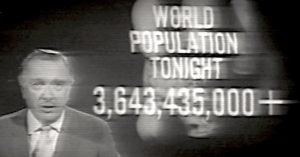
“While you are reading these words four people, most likely children, will die of starvation—and twenty-four more babies will have been born”


In the 1960s, a new kind of fear began to spread across America. The idea that the rapid growth of population will eventually deem Earth inhabitable to mankind was powerful and controversial. It struck fear in a massive audience leading to radical proposals, discrimination against large families, and a disposition of doom that fell over largely populated areas. This alarming reality check was delivered to the world by one scientist: Dr. Paul R. Ehrlich.
Ehrlich was originally a biologist at Stanford who specialized in the study of butterflies. After one trip to the overcrowded streets of Delhi, his focus immediately changed from insects to the infestation of a much more complex species: mankind. His concern was straightforward: “We live in a finite planet with finite resources. With such a system, you can’t have infinite population growth.” (2015 Interview population bomb documentary).
Dr. Ehrlich became the grim reaper of human existence. In 1968, the biologist came out with “The Population Bomb”. Millions purchased the book and were shocked by Ehrlich’s apocalyptic prophesies. He warned that hundreds of millions of people would starve to death by the 1970’s, that 65 million of them would be Americans, that overcrowded India was doomed beyond repair, and that “England will not exist in the year 2000”. In 1970, he predicted that the end of mankind was right around the corner.
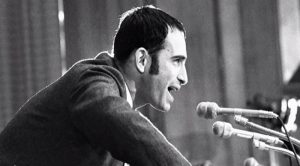
“Sometime in the next 15 years, the end will come. By ‘end’, I mean an utter breakdown of the capacity of the planet to support humanity.”
Ehrlich’s warnings and proposed methods of worldwide birth control kick started an international trend of fear-fueled protests and demonstrations, defending both sides of the controversial argument. One in particular was headed by a former student of Ehrlich, who demonstrated what post carrying-capacity America might look like by leading a public starvation demonstration.
The biologist’s calls for immediate action led to the formation of the Zero Population Growth organization. During his appearance on the Tonight Show, Dr. Ehrlich explained the philosophy behind ZPG: “We have to get the death rate and birth rate in balance and there’s only one of two ways to do it: one is to bring the birth rate down, the other is to push the death rate up”. Support for ZPG spread throughout America as the number of members went from six hundred to six hundred thousand. Commercials and newspaper articles encouraged married couples to limit themselves to two children, creating a negative stigma for families that exceeded this number. Ehrlich’s proposals for reducing the birth rate were radical, but to him, necessary. He advocated using force if voluntary methods failed along with: a “responsibility prize” for childless marriages, taxes on children, luxury taxes on diapers and cribs, and additive chemicals in public water that would decrease fertility.
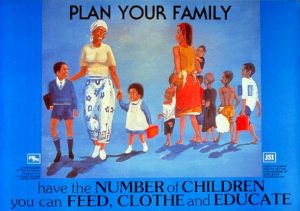
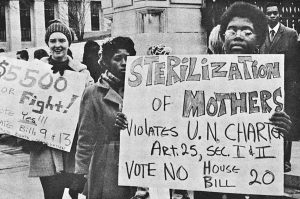
Women protesting the sterilization of mothers: Racial discrimination became a factor in the controversy when colored families were targeted by ZPG advocates to limit their families.

Student of Paul Ehrlich, leader of a demonstration that involved 60 people starving in public: “There’s too many people and we would like to see people have fewer children and better ones…
“Anyone who’s thinking of having a third child should try going hungry for a week”

Underdeveloped countries, which are more vulnerable to the environmental consequences of overpopulation, had already started implementing birth control methods. In the mid 1970s, the Indian government went to unethical extremes to encourage mass sterilization. Some communities were bribed into sterilization with food aid and free health care, while others were sterilized by force. A 1970s American News Station reported that over 8 million sterilizations had been performed in India, many by force. The anchorman described the inhumane treatment of the women, equating it to the treatment of cattle. Another station described the scene as a

deadly assembly line where “83 women were operated upon in a span of just six hours by a single doctor.” Protests flooded the streets of India, which authorities responded to with firearms. Over fifty protesters were shot down and killed during one demonstration.
So what ever came of the feared population bomb?
As we can see by the overabundance of food in America and the existence of England and India, Ehrlich’s drastic claims did not become reality. He predicted that by the 1970s, India would be starving. The case was quite the opposite. The Green Revolution, which peaked in the 1970s and 80s, created an agricultural boom by introducing new farming techniques and technology. The population growth may have been booming, but the economic explosion left an impact that was even more powerful than Ehrlich’s warnings: optimism.

A common criticism of Dr. Ehrlich’s theories is that humans are conscious, problem-solving beings. When we see a factor that has the potential to threaten our existence, we implement regulations and awareness. An example of this would be the Clean Air and Water acts in America. We have the unique ability to change our destiny.
Many parts of the world are even dealing with the flip-side of the population bomb: a “baby bust”. Counties in Asia and Europe are calling for another baby boom to manage issues related to the aging population and a lack of women in certain parts of the world.
Although the majority of his ominous predictions did not come true, Paul Ehrlich was successful in bringing a pending issue to surface and spreading awareness. Although the national policy in India has changed and no longer requires sterilization, the country has seen a voluntary decrease in family size. The population bomb was defused by urbanization, the Green Revolution, and efforts towards food distribution. In a 2014 interview, Ehrlich admits that there are things in the past the he would not have written today. But his core message and beliefs remain unfazed by the fortunate turn of events in the world.
Adopting his infamous tone of doom, Ehrlich explains that there are currently more than 4.5 billion people in the world, and the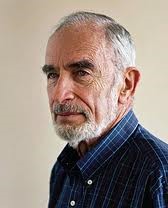 y are consuming more resources than ever before.
y are consuming more resources than ever before.
“I do not think my language is too apocalyptic in “Population Bomb”. My language would be even more apocalyptic today. The idea that every woman should have as many babies as she wants is, to me, exactly the same kind of idea as everybody being permitted to throw as much garbage into their neighbors’ backyard as they want.”
As the world continues to see a growth in people and the consequential depletion of the environment, Ehlrich’s ominous warnings still echo in the hearts of humanity.
“Too many cars, too many factories, too much detergent, too much pesticides, multiplying contrails, inadequate sewage treatment plants, too little water, too much carbon dioxide – all can be traced easily to too many people”
-Ellie Hunt
News report picture: https://static01.nyt.com/images/2015/06/01/blogs/dotpopcronkite/dotpopcronkite-facebookJumbo.jpg
Population bomb documentary: https://www.youtube.com/watch?v=W8XOF3SOu8I
Article: https://www.nytimes.com/2015/06/01/us/the-unrealized-horrors-of-population-explosion.html
Ehrlich 2014 portrait: https://swh-826d.kxcdn.com/wp-content/uploads/2010/12/Paul-R-Ehrlich.jpg
Plan your family poster: https://www.theguardian.com/world/2014/nov/12/india-sterilisation-deaths-women-forced-camps-relatives
India sterilization: https://www.theguardian.com/world/2014/nov/12/india-sterilisation-deaths-women-forced-camps-relatives